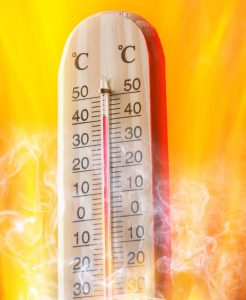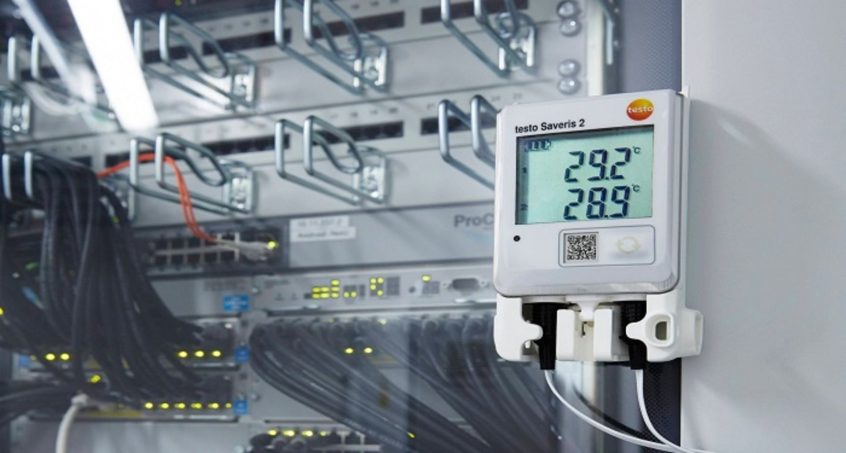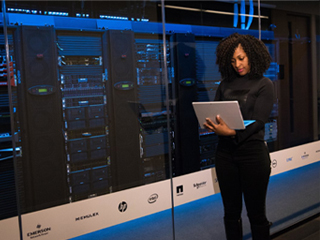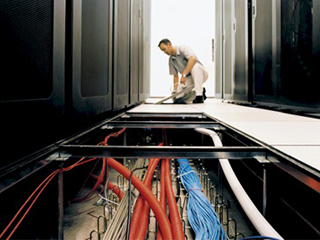It is common knowledge that data centers consume huge amounts of power. Almost all this power is dissipated as heat which must be removed. It is no secret that the cooling system after the IT equipment consumes the majority of the energy in the data center. In some poorly designed and managed data centers the cooling power can even be higher than the IT energy consumption. This ratio of IT and cooling power is known as Power Usage Effectiveness (PUE). Therefore, finding the right solutions for data center cooling and server temperature monitoring is vital.
Server Temperature Monitoring Is Fundamental

Photo Credit: datacenterdynamics.com
Features Of Temperature Server Monitoring Solutions
-
Alarms. This is the essence of having a temperature monitor in the server rooms. Operators need to be informed of any change that can be potentially dangerous to the facility. Temperature monitors today can send real-time alerts via SMS texts, emails, or phone calls.
-
Data Storage. Storage capacity is a basic feature for all types of monitors. All monitors must have some sort of data storage to keep track of the changes in the history of the temperature fluctuations in the server room.
-
Software. Monitors are connected to software where it can be controlled, managed, and tracked.
-
Temperature Measurement Device. This is considered as the “heart” of a temperature monitoring solution. It is connected to the sensor to measure and record the temperatures in the server room. A temperature measurement device can be a standalone device with local memory to store data. Or it can be a network-connected device with or without local memory.
-
Temperature Sensor. This feature affects the measurement accuracy and range or distance between the temperature monitor and the equipment.
-
Thermal Buffer. It aids in improving the quick changes in temperature at the sensor. Typically caused by the compressor cycling and door opening as well as loading and removing equipment in the server room.
Advantages Of Temperature Server Monitoring

Photo Credit: www.serverroomenvironments.co.uk
-
Achieving Optimal Cooling. The amount of heat generated by servers depends on the load on hard drives. Typically, servers have a heavier load during the daytime. You can decrease the cooling temperature at this point. As server load is typically lesser at night, server temperatures are lower as well. Adjusting the cooling setting will help you save energy consumption.
-
Extending the lifespan of your servers. Operating at suggested temperature ranges helps prolong the lifespan of your servers. Changing your server hardware would not be so frequent. When servers operate at a temperature higher than the threshold, your monitor system will immediately send an alert. Preventing damage before it can even happen.
-
Getting familiar with cooling load and heat load. Temperature monitors help you to find the right cooling load to maintain the right server room temperatures. It provides vital information in addressing the cooling load in the server rooms.
-
Identifying hotspots. Temperature sensors must be placed in strategic locations. This will show the uneven air distribution patterns in the room. It will help you find the hotspots so you may address these issues quickly.
-
Preventing downtime and network outages. Overheating leads to downtime and network outages. It can even lead to a total system failure. With the help of temperature monitors, you can avoid overheating. This system helps you diagnose problems and prevent issues that lead to greater inconvenience.
AKCP – Your One-Stop Shop For Data Center Monitoring Solutions
AKCP makes a number of devices that allow real-time server tool monitoring. Temperature, lighting, moisture, alarms, door status, and other factors may all be monitored via a web browser. Because AKCP solutions include built-in web servers, you won’t need any software agents or cloud services to collect performance statistics.
There is a threshold-based alarm mechanism in place. The user sets thresholds and receives an email or SMS message if they are exceeded.
-
Monitor all your devices with AKCPro Server Central Monitoring Software. All deployed AKCP base units and attached sensors can be configured and monitored from AKCPro Server (APS). Base units communicate with the server through your wired local network (LAN) or wide area network (WAN). Remote sites with no wired network send data to the server through the cellular data network.
-
Integrated Monitoring of All Devices. AKCPro Server integrates all your environmental, security, power, access control, and video in a single, easy-to-use software.
-
Environmental Monitoring. Monitor all your temperature, humidity, airflow, water leak, and other environmental sensors. Configure rack maps to show the thermal properties of your computer cabinet, check the temperature at the top, middle, bottom, front, and rear, as well as temperature differentials.
-
Security Monitoring. Ensure that your facilities and critical infrastructure are secured. Door contact sensors, audible and visual alarms are configured and managed from your custom desktops in APS.
-
Power Monitoring. Monitor single-phase, three-phase, generators, and UPS battery backup power. AKCPro Server performs live Power Usage effectiveness (PUE) calculations. So, you have a complete overview of your power train and how adjustments in your data center directly impact your PUE.
-
Access Control. AKCPro Server is used to administer the access rights and schedules for all AKCP Door Control, Cabinet Control, and RFID Cabinet locks. Secure your assets, control access, and generate reports to give a complete audited trail of access.
-
Video Monitoring. Video feeds from Integrated ONVIF compatible IP cameras and cameras connected to AKCP securityProbe base units can be monitored and recorded in AKCPro Server. Synchronize sensor events with video in the playback window for an “eyes on” to any sensor events.
Conclusion
Reference Links:
https://www.theseverngroup.com/proper-temperature-for-a-data-center/
https://www.withnellsensors.co.uk/the-importance-of-server-room-temperature-monitoring/
https://www.techbriefs.com/component/content/article/tb/pub/features/articles/35462
https://www.poweradmin.com/blog/the-top-5-benefits-of-temperature-server-monitoring-solutions/
https://www.akcp.com/akcp-products/akcpro-server/






